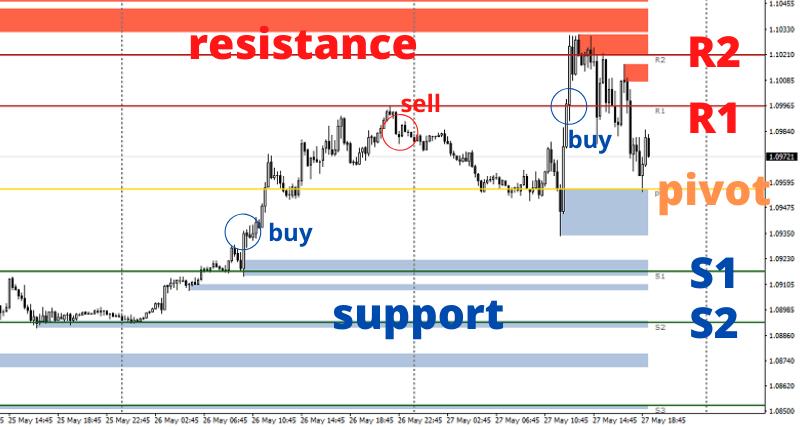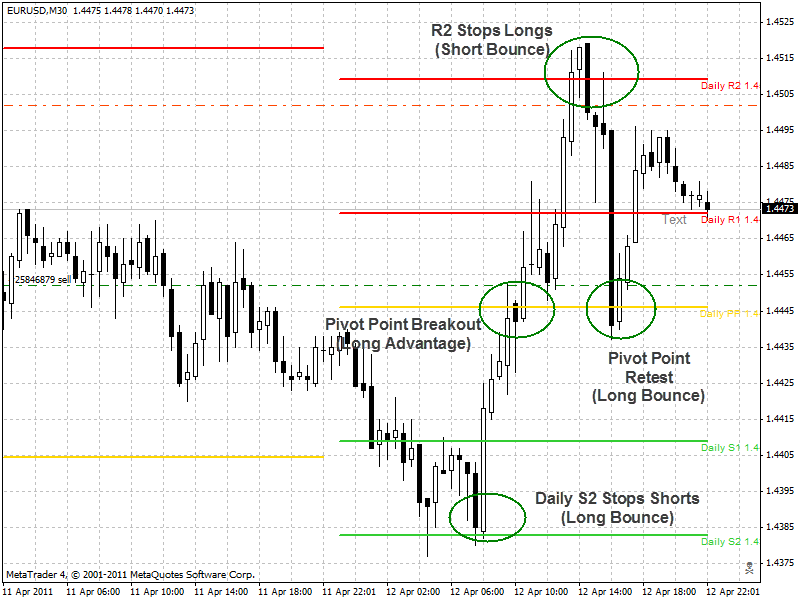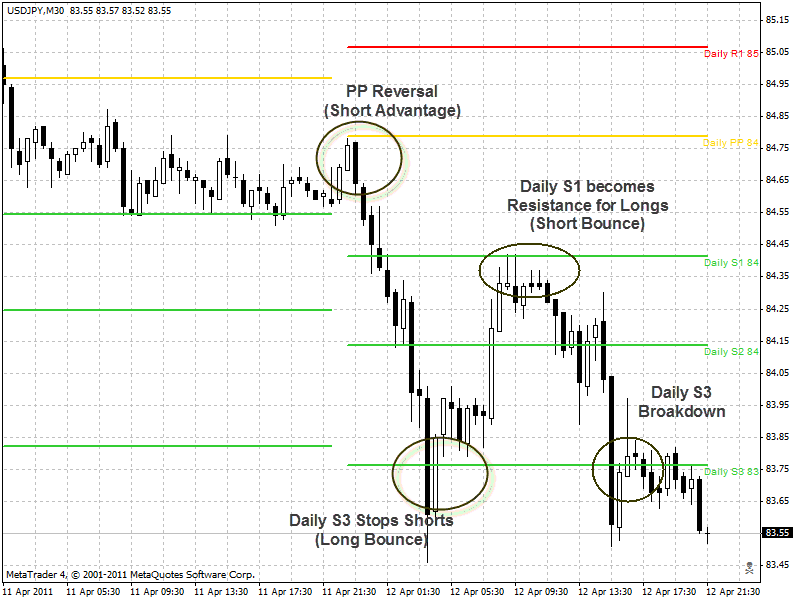
Có những lợi ích to lớn khi giao dịch bằng cách sử dụng các đường hỗ trợ và kháng cự và chúng phải là vũ khí chính của mọi nhà giao dịch. Một cách hiệu quả khác để rút ra nhiều đường hỗ trợ và kháng cự theo chiều ngang là sử dụng công thức bắt nguồn từ các thanh cao, thấp và đóng của ngày hôm qua. Tìm hiểu Điểm xoay Forex là gì, một chiến lược giao dịch được các nhà giao dịch chuyên nghiệp sử dụng rộng rãi và cách giao dịch chúng thành công trong bài viết đầy đủ này.
Công thức này vẽ một mức trục bao gồm ba cấp: trục, hỗ trợ và kháng cự. Các mức này được giao dịch theo cách tương tự như các mức hỗ trợ và kháng cự thông thường và đường xu hướng, sử dụng các điểm đột phá và bật lên. chiến lược danh mục đầu tư.
Ưu điểm chính của kỹ thuật điểm xoay này là nó "khách quan" vì nhiều nhà giao dịch sử dụng cùng một mức dựa trên cùng một công thức. Không có sự tùy ý nào có liên quan. Ngược lại, các phương pháp vẽ mức hỗ trợ, kháng cự và đường xu hướng có thể chủ quan và ấn tượng hơn (mỗi nhà giao dịch có thể nhận thấy và vẽ các đường khác nhau), mặc dù DeMark và những người khác đã cố gắng làm cho chúng khách quan hơn.
Lợi ích liên quan thứ hai của việc sử dụng chúng là vì có quá nhiều người tập trung vào những cấp độ này nên họ trở nên tự thỏa mãn. Lý do điểm mấu chốt rất phổ biến là vì chúng mang tính dự đoán hơn là tụt hậu. Bạn sử dụng thông tin của ngày hôm trước để tính điểm đảo chiều (hoặc mức đột phá) cho ngày giao dịch hiện tại. Bởi vì rất nhiều nhà giao dịch (bao gồm cả các nhà giao dịch tổ chức lớn) tuân theo các điểm xoay, nên thị trường sẽ phản ứng ở các mức này, mang lại cho bạn cơ hội giao dịch. Giống như chúng ta đã thấy với các mức hỗ trợ và kháng cự hành động giá, nhà giao dịch có thể chọn giao dịch ở mức phục hồi hoặc đột phá các mức này.
Các mức này được tính như thế nào?
Đây là công thức kỳ diệu:< /span>
Kháng cự 3 = Cao + 2*(Xoay – Thấp)
Kháng cự 2 = Xoay trục + (R1 – S1)
Kháng cự 1 = 2 * Xoay – Thấp
Điểm xoay = ( Cao + Đóng + Thấp )/3
Hỗ trợ 1 = 2 * Xoay – Cao
Hỗ trợ 2 = Xoay – (R1 – S1)
Hỗ trợ 3 = Thấp – 2 *(Cao – Xoay)
Điều tôi thấy thú vị là chỉ cần nhìn vào mức cao, thấp và đóng cửa của ngày hôm trước, bạn sẽ có 7 điểm: điểm xoay thực tế, 3 vị trí điểm kháng cự và 3 mức hỗ trợ . Ba loại phổ biến nhất là PP, R1 và S1.
Nếu bạn ghét đại số và ý tưởng sử dụng máy tính cũng như công cụ vẽ đồ thị để suy ra và vẽ biểu đồ các cấp độ này hàng ngày, thì bạn không cần phải sợ hãi. Công thức trên chỉ là giải thích lý thuyết chứ không phải là thứ bạn phải tính toán hàng ngày. Có nhiều chỉ báo MT4 có thể thực hiện việc này cho bạn, tự động tính toán các mức và vẽ chúng rõ ràng cho bạn trên biểu đồ.
Có nhiều cách để giao dịch bằng cách sử dụng các điểm xoay được tính toán này, chúng ta sẽ thảo luận về ba trong số đó:
Chiến lược số 1: Giao dịch xoay vòng thoát ra (Đảo ngược)
Nếu bạn hiểu rõ về hướng chung của thị trường, bạn có thể giao dịch bật lên từ điểm xoay ở thời điểm mở cửa so với hướng của thị trường so với PP.
Nhiều nhà giao dịch xem điểm xoay là trọng tài chính cho việc thị trường sẽ tăng hay giảm. Nếu thị trường bắt đầu giao dịch trong ngày trên điểm xoay, nó được cho là tăng (tăng) và nếu nó bắt đầu giao dịch trong ngày dưới điểm xoay, nó được cho là giảm (giảm).
| Tín hiệu Phương hướng | Điều kiện |
|---|---|
| tăng | Nếu thị trường bắt đầu ngày trên PP |
| < span jsaction="mouseup:Sxi9L,BR6jm; mousedown:qjlr0e" jsname="jqKxS">Giảm | Nếu thị trường bắt đầu ngày ở mức dưới PP |
Ngoài ra, Một cặp tiền tệ càng chạm điểm xoay và sau đó đảo chiều thì mức đó càng mạnh và điểm xoay chỉ đơn giản có nghĩa là đạt đến mức hỗ trợ hoặc kháng cự rồi đảo chiều.
Vì vậy, bằng cách sử dụng điểm xoay làm cơ sở cho định hướng chung, bạn có thể thử giao dịch thoát khi thị trường kiểm tra lại điểm xoay.
Entry & Exit Rules:
| Entry & Exit Rules | Long | Short |
|---|---|---|
| Quy tắc tham gia | Nếu giá bắt đầu cao hơn PP, sau đó vào Mua với lệnh thị trường hoặc lệnh giới hạn tại hoặc gần đường PP. Nếu bỏ lỡ PP và thị trường tăng mạnh, có các giao dịch thay thế theo hướng PP ủng hộ lệnh mua: Nếu thị trường dừng ở R1 hoặc R2 và quay trở lại PP, bạn có thể tham gia giao dịch mua từ đợt phục hồi PP . | Nếu thị trường bắt đầu Nếu nó thấp hơn PP, hãy bán theo lệnh thị trường hoặc lệnh giới hạn tại hoặc gần đường PP. Nếu bỏ lỡ PP và thị trường giảm mạnh, có các giao dịch thay thế theo hướng PP: nếu thị trường dừng ở S1 hoặc S2 và quay trở lại PP, bạn có thể tham gia giao dịch bán khống từ đợt phục hồi PP . |
| Quy tắc gia nhập (bảo thủ) | Bạn Người ta có thể hy vọng rằng thị trường chạm (và chạm lại) đường này (hoặc thậm chí chờ xem nó phá vỡ bao xa) và chỉ giao dịch nếu thị trường đóng x điểm trên mức PP, cho thấy đường này vẫn mạnh td> | Bạn có thể muốn thị trường chạm (và chạm lại) đường này (thậm chí chờ xem nó phá vỡ bao xa) và |
| Quy tắc dừng lỗ | SL thấp hơn PP một vài điểm hoặc cao hơn S1 < /span> Giao dịch phòng< /td> | SL cao hơn PP vài điểm hoặc cao hơn R1 để có nhiều không gian giao dịch hơn |
| Quy tắc lợi nhuận | TP ở mức S2, nếu đạt S1 thì chuyển SL về mức hòa vốn | TP là R2, nếu giá đạt R1 thì chuyển SL về mức hòa vốn |
| Quy tắc vào và ra | Dài | Ngắn |
|---|---|---|
| Thể lệ cuộc thi | Nếu giá ở dưới PP và vượt lên trên PP, thì Mua theo giá thị trường hoặc điểm dừng lỗ cao hơn mức PP. Ngoài ra, nếu bạn bỏ lỡ một điểm đột phá, bạn có thể mua bản kiểm tra lại điểm đột phá ở cấp PP. Nếu đột phá quá nhanh và không có đợt kiểm tra lại, bạn có thể mua R1, miễn là động lượng mạnh và có vẻ như sắp có đột phá. | Nếu giá đã vượt quá PP và giảm xuống dưới PP, hãy bán ra thị trường hoặc dừng nhập x điểm dưới mức PP. Ngoài ra, nếu bạn bỏ lỡ điểm đột phá, bạn có thể bán điểm đột phá ở cấp PP để có thể kiểm tra lại. Nếu đột phá quá nhanh và không có đợt kiểm tra lại, bạn có thể bán khống trên S1. Chỉ cần động lượng còn mạnh thì có vẻ như nó sẽ đột phá. |
| Nhập quy tắc (bảo thủ) | Nếu giá phá vỡ PP và H1 đóng cửa trên mức đó thì bạn có thể đặt lệnh giới hạn mua tại PP để kiểm tra lại. | Nếu giá giảm xuống dưới PP và H1 đóng cửa dưới mức này, khi đó bạn có thể đặt giới hạn bán ở mức PP để kiểm tra lại. |
| Quy tắc dừng lỗ | SL cố định điểm dưới PP hoặc một vài điểm dưới mức S1 để có thêm không gian giao dịch | SL đã cố định các điểm trên PP hoặc một vài điểm trên mức R1 để có thêm không gian giao dịch |
| Quy tắc lợi nhuận< /span> | TP tại R2. Nếu giá đạt R1, hãy đặt mức SL của bạn thành PP để giảm thiểu rủi ro. | TP 在 S2。 Nếu giá đạt đến S1, hãy đặt SL của bạn thành mức PP để giảm thiểu rủi ro. |
Ví dụ về EURUSD M30 sử dụng trục xoay hàng ngày:
 < /p>
< /p>
Trong biểu đồ trên, EURUSD mở cửa dưới mức PP, cho thấy xu hướng giảm giá trong ngày. Các nhà giao dịch bắt đầu bán khống cặp này và thay vì chờ kiểm tra PP, họ bán khống cho đến khi nó dừng ở S2. Kiểm tra S2 một lần nữa và khi nó được giữ vững, người tăng giá chờ đợi S2 đã đẩy thị trường lên mức xoay 1.4045 và một trận chiến ngắn ngủi kéo dài 2 giờ bắt đầu. Thanh H2 đầu tiên chạm tới điểm xoay phá vỡ 10 điểm, điều này sẽ mang lại cho Bulls một chút hy vọng. Tuy nhiên, thanh tiếp theo giảm trở lại 25 pip, và tại thời điểm đó, khi nó giảm, những người bảo vệ trục giảm dường như đã thắng và EURUSD đã bị từ chối thành công tại trục. Tuy nhiên, nếu bạn nhìn kỹ vào chân nến, thanh này kết thúc bằng một sự thay đổi thú vị: Bóng dài phía dưới cho thấy phe Bears kiểm soát bóng trong một phần trận đấu, nhưng đã mất kiểm soát trong cuộc lội ngược dòng ấn tượng của Bulls. Sự đảo chiều này rất ấn tượng và nó khuyến khích phe Bò đẩy thị trường trực tiếp vượt qua PP của thanh tiếp theo, với thế trận xoay chuyển theo hướng có lợi cho họ trong thời gian còn lại của ngày khi PP bị phá vỡ thành công. Mức R1 đã chiến đấu thêm 4 giờ nữa, nhưng cuối cùng đã bị loại bỏ khi phe Bulls đẩy thị trường lên mức R2.
Hãy chú ý cách phe giảm giá rút lui trong ngày đã tổ chức một cuộc phản công đẹp mắt trên R2, khiến thị trường giảm mạnh để kiểm tra lại mức PP. Đây là một ví dụ điển hình về chiến lược số 3 được thảo luận bên dưới, trong đó người ta có thể bán trên thị trường R2 hoặc R3 để tận dụng các điều kiện mua quá mức (hoặc mua trên thị trường S2 hoặc S3 để tận dụng các điều kiện bán quá mức). Người vệ sĩ lùn ở R2 lẽ ra đã nhanh chóng đạt được 60 điểm.
Tuy nhiên, ngày thi đấu lại có lợi cho Bulls vì Bulls đã phá vỡ được PP trước đó trong ngày, do đó xoay chuyển thế trận theo hướng có lợi cho họ, vì vậy Bears đã từ bỏ cuộc phản công chống lại PP và Bulls có một cơ hội khác để chơi trong đợt phục hồi PP.
Do tính đặc thù và phổ biến của nó, EUR/USD là một loại tiền tệ tuyệt vời được sử dụng để thúc đẩy các chiến lược xoay trục.
Nguy cơ đột phá trục:< / h3>
Mọi nỗ lực giao dịch theo hướng đột phá trục đều đi kèm với rủi ro cố hữu là trục sẽ vẫn mạnh. Bạn không biết liệu chuyển động ban đầu qua trục có tiếp tục hay không. Bạn đang có chiến tranh với Pivot Bouncers ở phía bên kia của Pivot và sương mù chiến tranh trong tình huống này cũng khó khăn như trên chiến trường trực tiếp. Có rất nhiều đòn nhử, phục kích và đột phá giả đang chờ đợi bộ binh đột phá dũng cảm. Bạn có thể nghĩ rằng giá đã bứt phá thành công, nhưng bạn có thể bị dụ vào bẫy khi người trả giá nhấn chìm vị trí của bạn và đẩy bạn trở lại điểm dừng lỗ. Một đột phá dường như đã xảy ra nhưng không tiếp tục theo hướng đột phá được gọi là đột phá giả - không phải đột phá xảy ra là sai mà là kết luận của bạn về quỹ đạo của nó. Bạn phải có khả năng đọc nhanh địa hình, đó là thời điểm xảy ra đột phá và các chân nến hình thành ngay sau đó, để giúp bạn hiểu cách đạt được đột phá. Nếu bạn là Bull Pivot Breaker, bạn muốn thấy một dạng nến trắng đặc sau đột phá (lý tưởng nhất là có giá đóng cửa gần mức cao) và nếu nến trắng trước đó của bạn co lại như một bóng ma, bạn sẽ muốn Ở lại cảnh báo Đóng ở mắt cá chân của vùng thấp, vì đó là dấu hiệu cho thấy đồng đội của bạn đang rút lui khỏi phạm vi và bạn nên sẵn sàng thoát ra nhanh chóng. Bạn cũng muốn đảm bảo rằng bước đột phá của mình là một bước đột phá thực sự về công nghệ chứ không phải do một động thái điên rồ nào đó gây ra trong một bản tin quan trọng. Sự biến động tăng đột biến là điều thường thấy trong các sự kiện mới và các nhà giao dịch nên biết về lịch Forex để biết những ngày có liên quan.



